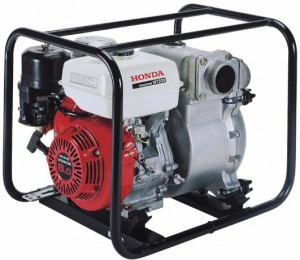Honda’s WT20 and WT30 pumps make it easy to move dirty water, but improper use can lead to poor performance and even damage to the pump. Here’s what you need to know to set up and use your pump so you can get the most from it.
Placing the Pump
Always keep the pump at least three feet away from buildings and awnings to prevent fires from engine heat and buildup of deadly carbon monoxide from the exhaust.
The WT20 has a maximum total head of 85 feet, while the WT30 can lift water up to 82 feet. Both have a maximum suction head of 26 feet. The pump will work faster with a shorter head. When making a choice between suction and outlet head, go for a shorter suction head. This will decrease power demands on the pump, increasing the pumping rate.
Before Use
Check the pump for signs of gas and oil leaks, and make sure the bolts on the pump are tight.
Clean off any dirt around the starter and muffler.
Inspect the hoses for cuts and other damage. Make sure the sealing washer that goes in the suction hose connector is good condition and that both connectors are secure. Check the strainer at the end of the suction hose, clearing it of debris and checking the connection.
Check the oil level, air filter, and fuel tank. Oil Alert will turn the engine off automatically if the oil level is too low, but checking ahead of time will keep you from having unexpected shutdowns.
Attaching the Suction Hose
The parts attaching the suction hose to the pump inlet should be installed in this order: sealing washer, hose coupler, hose clamp ring, suction hose and hose clamp. These pumps can handle solids up to 13/16 inch in diameter: anything larger can damage the impeller and housing. To keep this from happening, the suction hose should always be used with a strainer.
The parts that connect the discharge hose should be installed in this order: hose connector, discharge hose, and hose clamp.
Priming the Pump
Remove the filler cap on the top of the pump chamber and fill the chamber with clean water. Screw the cap back onto to the pump chamber.
If you started the engine without priming the pump, stop the engine immediately. Let the pump cool completely before priming the chamber and restarting the engine. If the pump is used when dry, the resulting heat can destroy the pump seals.
Starting the Engine
The controls for the engine are located directly below the air cleaner box.
– Move the fuel valve lever to “On.”
– If the engine is cold, move the choke lever to “Closed.” If the engine is warm, leave the choke open.
– Move the throttle lever about 1/3 of the way from the “Slow” position.
– Turn the ignition switch to “On.”
– Pull the starter grip. The engine should fire up after the first or second pull.
If the choke is closed, open it gradually as the engine warms up.
Setting Pump Speed
Once the engine is warm and it’s running with the choke open, move the throttle to the “Fast” position. The pump will pull water through the hoses. After water comes out of the outlet hose, the throttle can be set to get the desired pumping speed.
Stopping the Engine
The pump can be stopped immediately by turning the ignition switch off. Unless you have an emergency, it’s better to move the throttle lever to “Slow” and let the engine reach idle speed before turning the ignition switch. Once the engine is off, move the fuel valve lever to the “Off” position.
After Use
Remove the case drain plug and cover drain plugs from the base of the pump case. Once water stops dripping out of these openings, remove the filler cap on the top of the pump case and pour in some clean water. This will flush out any dirt or debris left inside the pump. After this water has drained out, the drain plugs and filler cap can be screwed back into the pump.
The Parts You Need for Your Honda Pump are Just a Few Clicks Away
Hondalawnparts.com carries replacement parts and accessories for all Honda power equipment. Our pump accessory section has the hoses, clamps, and seals you need to use your pump, and our parts section has everything you need to maintain your equipment. Not sure what part to order? Select your model and serial number, and our site can show you parts using factory descriptions and exploded parts diagrams. We ship across the United States and Canada.

